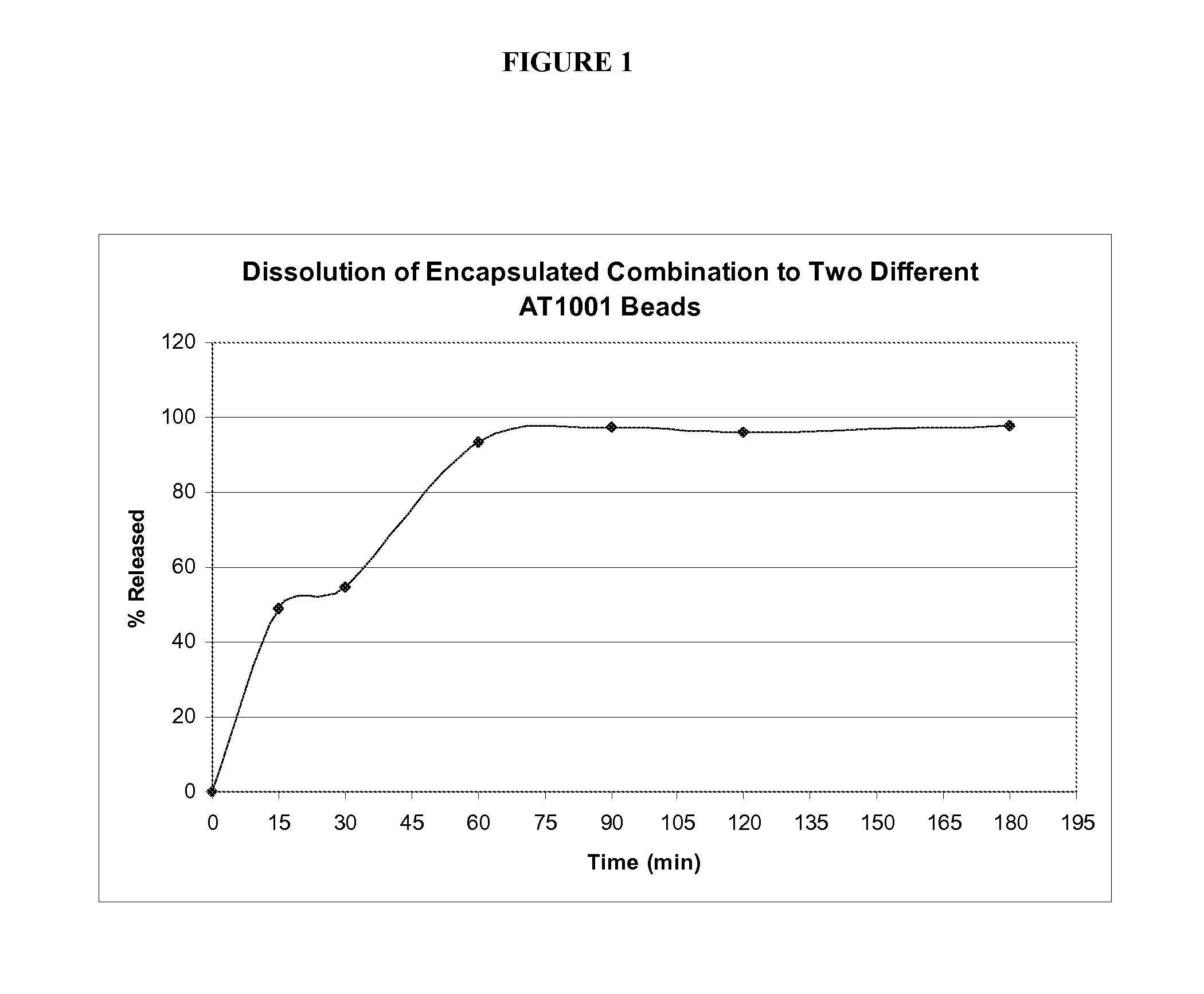Formulations for a tight junction effector
a technology of effector and form, applied in the direction of peptide/protein ingredients, immunological disorders, metabolism disorders, etc., to achieve the effect of stable gastric fluid and stable gastric fluid
- Summary
- Abstract
- Description
- Claims
- Application Information
AI Technical Summary
Benefits of technology
Problems solved by technology
Method used
Image
Examples
example 1
[0096] Preparation of a delayed-release particle comprising a tight junction antagonist
[0097] A base coat containing the tight junction antagonist of SEQ ID NO: 1 was prepared by mixing 2000 g of water, slowly adding 15 g of the antagonist peptide. Once the peptide was dispersed, 15 g of Bakers Special Sugar was added. Total weight was adjusted to 2107 g with additional water. One skilled in the art will appreciate that binders other than Bakers Special Sugar may be used. Suitable binders are typically pharmaceutically acceptable binders including, but not limited to, starch, gelatin, natural sugars such as glucose or beta-lactose, corn sweeteners, natural and synthetic gums such as acacia, tragacanth or sodium alginate, carboxymethylcellulose, polyethylene glycol, waxes and the like. Other suitable binders include pharmaceutically acceptable binders such as polyvinyl pyrrolidone, hydroxypropyl cellulose, hydroxyethyl cellulose, ethylcellulose, polymethacrylate, waxes and the like....
example 2
[0102] The stability of delayed-release particles containing 4-6% tight junction antagonist peptide (SEQ ID NO: 1) was performed. Delayed-release particles prepared as described above were exposed to Simulated Gastric Fluid (SGF) containing 0.1% v / v Tween 80K under controlled temperature (37° C.±0.5° C.) and agitation in a dissolution apparatus for 1 hour. The beads were removed from the SGF and exposed to Simulated Intestinal Fluid (SIF) containing 0.1% v / v Tween 80K. Samples were pulled from the bath and analyzed by HPLC at 220 nm on a Inertsil ODS-2 HPLC Column (150 mm×3 mm, 5 μm) with an Inertsil ODS-2 HPLC Guard Column (20 mm×4.6 μm, 5 μm). Mobile Phase A: 92:8 Water:ACN, 0.1% TFA Mobile Phase B: ACN, 0.1% TFA ). The chromatographic conditions are shown below.
TimeFlow rate(min)(mL / min)% H2O 0.1% TFA% CH3CN 0.1% TFA01.5982101.553.446.610.11.5010011.91.50100121.598217982
Run time: 17 min
Detection: 220 nm
Response time: 0.5 sec
Column Temp.: 40° C. ± 1° C.
Auto Sampler Temp: 10°...
example 3
[0107] Preparation of Multiparticulate Enterically Coated Bead Formulation for Delayed-Release of Tight Junction Effectors
[0108] This embodiment provides for encapsulaton of a combination of a plurality (e.g., 2, 3, 4, 5 etc) of different enterically coated beads. Any amount of each type of bead may be encapsulated. In some embodiments, two different beads may be encapsulated in any proportion. In one specific embodiment, almost equal proportions of two beads may be encapsulated. Each bead may be coated with any suitable coating material at any suitable coating level. In some embodiments, two beads may be coated with Eudragit L30 D55 at 20 and 70% coating levels. A formulation comprising 20% and 70% coating levels allows for the delayed-release of one or more tight junction effectors (e.g. AT1001) into both the duodenum and jejunum. For calculation of weight percentage, weight measurements are done before the two substances are put together. For example, a 70% coating level is 70 g...
PUM
| Property | Measurement | Unit |
|---|---|---|
| Fraction | aaaaa | aaaaa |
| Fraction | aaaaa | aaaaa |
| Percent by mass | aaaaa | aaaaa |
Abstract
Description
Claims
Application Information
 Login to View More
Login to View More - R&D
- Intellectual Property
- Life Sciences
- Materials
- Tech Scout
- Unparalleled Data Quality
- Higher Quality Content
- 60% Fewer Hallucinations
Browse by: Latest US Patents, China's latest patents, Technical Efficacy Thesaurus, Application Domain, Technology Topic, Popular Technical Reports.
© 2025 PatSnap. All rights reserved.Legal|Privacy policy|Modern Slavery Act Transparency Statement|Sitemap|About US| Contact US: help@patsnap.com

